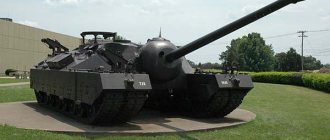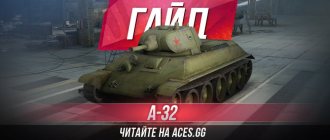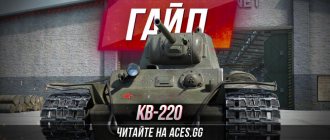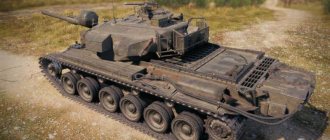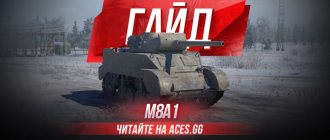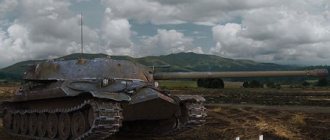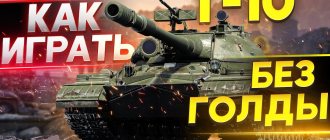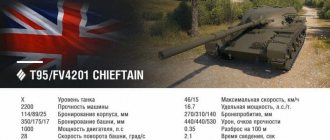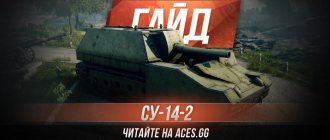In 1941, the KV-1 heavy tanks available in the Red Army fought without any problems with any armored vehicles of the Wehrmacht. The main enemy of the machines was the confusion of the first months of fighting, which led to large losses of people and equipment. In 1942, the heavy Tiger tank entered service with German units, which the KV-1 with a 76 mm cannon could no longer fight on equal terms with.
Beginning in 1942, projects of Soviet heavy vehicles armed with cannons of increased caliber began to appear. The most successful was the IS-1 tank, which served as the basis for the even more heavily armed IS-2 tank, which remained in service until the mid-90s.
History of creation
At the beginning of 1942, a project for further modernization of the KV-1/1s tanks was created in Chelyabinsk, which received the designation KV-13. The design of the vehicle widely used castings made of armored steel, connected by welding. The tank was intended to replace the T-34 and KV series vehicles as part of the concept of a single armored vehicle. But things did not go further than the construction of 3 prototypes.
In the fall of 1942, the first German heavy Tiger tanks appeared near Leningrad, which accelerated the start of work on a new Soviet vehicle with improved protection and armament. In the winter of 1943, a decree was issued on the need to develop and build prototypes of the heavy tank of the IS series, which arrived in Chelyabinsk and at the experimental tank plant No. 100.
The basis for development was the KV-13, and at the same time work was carried out on vehicles armed with 76 and 122 mm cannons (the future IS-1 and IS-2, respectively). By this time, the Soviet military had at its disposal a captured model of the Tiger tank, which was tested by fire from tank and anti-tank guns.
Due to the insufficient effectiveness of 76 mm artillery, it was proposed to create a new 85 mm gun based on the 52-K anti-aircraft gun. At the early stages, the possibility of using the 107 mm ZiS-26 cannon was also considered, but the lack of serial production of ammunition led to the abandonment of the idea in favor of the 85 mm system.
By the summer, two designs were ready, created by TsAKB and Design Bureau of Plant No. 9, which differed in design elements.
When trying to fit the gun into the turret, the designers came to the conclusion that it was necessary to expand the shoulder strap, which entailed a rearrangement of the tank hull. Due to the increase in length, a sixth torsion bar with a roller was introduced into the chassis (which was abandoned when creating the KV-13).
Since the development of the 85 mm system was ahead of the creation of the carrier, production of the KV-85 began in the summer of 1943. The final development of the first tank of the IS series, designated IS-85 (since March 1944 - IS-1), ended only in the fall, and in October the first 2 production vehicles were assembled. By this time, the IS-2 project was being actively finalized in Chelyabinsk, so the life cycle of the IS-1 turned out to be short.
Serial production of the vehicle ceased in January 1944; a total of 107 copies of the tank were assembled. In addition, there was a prototype of the tank, created as part of the work on “Object 248”, armed with a 100 mm S-34 gun.
Modules
| Penetration (mm) | Damage (HP) | Rapid fire (rounds/min) | Spread (m/100m) | Mixing (c) | Weight, kg) | Price (|) | ||
| VI | 85 mm D-5T | 120/161/43 | 160/160/280 | 12.35 | 0.46 | 2.86 | 1500 | 61530 |
| VII | 100 mm D-10T | 175/235/50 | 230/230/330 | 7 | 0.42 | 2.86 | 2257 | 78180 |
| VII | 85 mm D-5T-85BM | 144/194/44 | 165/165/290 | 10.31 | 0.37 | 2.86 | 1850 | 73600 |
| VII | 122 mm D2-5T | 175/217/61 | 390/390/465 | 4.07 | 0.46 | 3.43 | 2600 | 84980 |
| VIII | 122 mm D-25T | 175/217/61 | 390/390/465 | 4.86 | 0.46 | 3.43 | 2590 | 125140 |
| Armor (mm) | Rotation (gr/sec) | Review (m) | Weight, kg) | Price (|) | ||
| VI | IS-85 | 100/100/100 | 37.625 | 332.5 | 7200 | 15000 |
| VII | IS-122 | 100/100/100 | 28 | 350 | 7500 | 26300 |
| Power (hp) | Fire probability (%) | Weight, kg) | Price (|) | ||
| VII | V-2IS | 600 | 15 | 750 | 36000 |
| IX | V-2-54IS | 700 | 12 | 700 | 79290 |
| Max. load (t) | Turning speed (gr/sec) | Rmin | Weight, kg) | Price (|) | ||
| VI | IS-1 | 47.5 | 32 | B/2 | 11500 | 12990 |
| VII | IS-2M | 48.4 | 35 | B/2 | 11500 | 18080 |
| Communication range (m) | Weight, kg) | Price (|) | ||
| VII | 10RK | 440 | 100 | 18600 |
| IX | 12RT | 625 | 110 | 33600 |
Description of design
The hull of the IS-1 heavy tank consists of rolled armor sheets 20-90 mm thick and a cast nose section, connected by submerged arc welding. The cast front part has walls of variable thickness in the range of 30-120 mm. Moreover, during combat operation, a case was noted of a part being pierced in a thin place by an armor-piercing bullet fired from a Pz.B.41 gun.
The tower has a streamlined configuration, made using casting technology, wall thickness 100 mm.
The front part of the turret has a complex curved shape, bearing the gun embrasure, and is made as a separate part connected to the main element with bolts. The shoulder strap joint line was recessed into the plane of the hull roof, which reduced the likelihood of the structure jamming when hit by a projectile. A measuring scale was installed on the inner edge of the turret ring, which was used for aiming the gun when firing from a closed position.
Three crew members were housed in the turret; the driver's seat was located in the narrowed front part of the hull. On the side of the mechanic there was a point for installing a machine gun with a remote trigger drive; on later vehicles the mounting of the structure was abandoned. To monitor the terrain, the tank's turret had a turret of a cast structure in which observation devices were located.
The main armament of the IS-1 was the 85 mm D-5T cannon mounted in trunnions. The design of the gun made it possible to move the barrel horizontally at a small angle without rotating the turret. The tank's ammunition included 59 unitary cartridges with armor-piercing and fragmentation shells. A 7.62 mm DT machine gun was paired with the cannon; another barrel was located on the rear wall of the turret in a special tide.
The power unit included a 12-cylinder 520-horsepower naturally aspirated V-2-IS diesel engine and an original 4-speed gearbox with a 2-speed divider. Torque was transmitted to the rear drive wheels through planetary gearboxes with additional clutches, which ensured the vehicle's turn.
The chassis was equipped with torsion bars.
To limit the stroke of the balancers, there are steel bumpers on the body. The rollers are equipped with internal rubber shock-absorbing rings. The caterpillar track is made up of 86 tracks with a width of 650 mm, the tension is carried out by the crank of the front idler.
Surviving cars[edit]
There are several surviving IS series tanks, examples of which can be found at the following address:
IS-2
- OS. Górali [standing tank], Krakow, Poland
- Polish Army Museum, Warsaw, Poland
- Weapons Museum at Fort Winiary, Poznan, Poland
- Museum of Armored Weapons at the Land Forces Training Center, Poznan, Poland (active, see film)
- People's Liberation Army Tank Museum, Beijing, China.
- Freedom Park, Overloon, The Netherlands.
- Museum of the History of Ukraine in World War II, Ukraine
- Kurzeme Fortress Museum, Zante, Latvia.
- Diorama of the Battle of Kursk in Belgorod, Russia.
- American Heritage Museum, Greater Boston, USA
- Army Technical Museum, Lešany, Czech Republic [27] (formerly in Prague as a monument to Soviet tank crews)
IS-2M
- Imperial War Museum Duxford, England.
- Cuban Tank Museum, Russia.
- Victory Park (Park Pobedy - Victory Park), Ulyanovsk, Russia.
- Victory Park on Poklonnaya Hill, Moscow, Russia.
IS-3
- IDF Armored Corps Museum, Israel.
- Museum of Armored Weapons, Army Training Center, Poznan, Poland
- Military Technical Museum, Lešany, Czech Republic (current). [27]
- Polish Army Museum, Warsaw, Poland. (Fort Chernyakov, branch of the museum).
- National Museum of Armor and Cavalry, Fort Benning, Georgia, USA.
- Victory Park in the northern part of Ulyanovsk, Russia.
- Ulyanovsk SVU, Ulyanovsk, Russia
- Museum of Military Glory, Gomel, Belarus.
- Diorama of the Battle of Kursk in Belgorod, Russia.
- At least one IS-3 was used by the separatist government in the Donbass before being captured by Ukrainian forces.
IS-3M
- Egyptian National War Museum, Cairo Citadel, Egypt.
- Military Vehicle Foundation, California, USA. [28]
- Royal Museum of the Armed Forces and Military History, Brussels, Belgium. (still working)
IS-4
- Cuban Tank Museum, Russia.
IS-7
- Cuban Tank Museum, Russia.
Gallery[edit]
- IS-2
- IS-2M
- IS-2M in the Kubinkovsky Tank Museum
- IS-3 at the Leshany Military Technical Museum
- Heavy tank IS-3 in the Museum of Polish Military Equipment in Warsaw.
- Former Egyptian Army IS-3M
Technical characteristics of IS-1
The closest competitors of the Soviet IS-1 were the German heavy vehicles “Panther” and “Tiger”, armed with long-barreled 75 or 88 mm guns. The Pz.Kpfw.V tank, which was superior to the domestic vehicle in mobility, was somewhat inferior in armor, located at favorable angles.
The Pz.Kpfw.VI was a more dangerous enemy due to its thick armor and powerful 88 mm gun.
| IS-1 | Pz.Kpfw.VAusf.D | Pz.Kpfw.VIAusf.E | |
| Weight, kg | 44200 | 44800 | 57000 |
| Length (without barrel), mm | 6770 | 6870 | 6316 |
| Width, mm | 3070 | 3270 | 3705 |
| Height, mm | 2740 | 2995 | 2930 |
| Armor thickness, mm | 30-120 | 17-110 | 28-100 |
| Highway speed, km/h | 37 | 55 | 38 |
| Cruising range, km | 150 | 250 | 195 |
A common problem with German technology was the use of gasoline engines, which were not reliable. The use of a staggered suspension improved the smoothness of the ride, but in winter there were cases of the rollers jamming due to freezing mud. A big problem was replacing the internal rollers; to dismantle the unit, adjacent wheels had to be removed.
"M" series computers
While Academician Lebedev was working on an electronic computing device in Kyiv, a separate group of electrical engineers was being formed in Moscow. In 1948, employees of the Krzhizhanovsky Energy Institute Isaac Brook (electrical engineer) and Bashir Rameev (inventor) submitted an application to the patent office to register their own computer project. In the early 50s, Rameev became the head of a separate laboratory, where this device was intended to appear. In just one year, the developers assemble the first prototype of the M-1 machine. In all technical parameters, it was a device much inferior to MESM: only 20 operations per second, while Lebedev’s machine showed a result of 50 operations. The inherent advantage of the M-1 was its size and power consumption. The design used only 730 electric lamps, they required 8 kW, and the entire apparatus occupied only 5 m2.
Combat use
Is-1 tanks entered service with breakthrough regiments at the end of winter 1944, displacing the aging KV-1/1s. The crews included 2 officers and 2 sergeants, training was conducted at a training ground in the Tula region.
The first battle of the IS-1 was carried out in February, leading an offensive on the Fastov-Belaya Tserkov line.
German tanks, allowing Soviet vehicles to close range, opened fire, destroying several IS-1s. Three weeks later, several IS-1s were destroyed by 88 mm anti-aircraft guns during the battles near Uman.
In early to mid-March, battles between IS-1 and Tigers were recorded, which burned several IS-1 vehicles. At the same time, the return fire of Soviet tanks turned out to be ineffective due to the long combat distance (according to various estimates from 1.5 to 1.8 km). In the first ten days of the month, two tanks burned down as a result of fire from 75 mm Wehrmacht assault guns. These clashes once again confirmed the weakness of the IS-1 weapons and accelerated the saturation of the army with IS-2 vehicles.
The surviving IS-1s were used in various sectors of the front until the end of the war, and then were transferred to the category of training vehicles. Some vehicles took part in the assault on Berlin. The official date for removing the vehicle from service is May 1954.
Notes[edit]
- Zheltov I.G. et al. IS tanks
//Tankomaster (special issue), 2004 - Zheltov I. G., Pavlov I. V., Pavlov M. V., Solyankin A. G. Soviet heavy self-propelled artillery installations 1941-1945.
- https://www.battlefield.ru/index.php?option=com_content&task=view&id=149&Itemid=65
- ↑ https://armor.kiev.ua/Tanks/WWII/T34_85/t34_85_2.html
- ↑ Citation error Invalid tag; no text provided for footnotes
- Shmelev I.P. German armored vehicles 1934-1945: Illustrated reference book. - M.: Astrel Publishing House LLC, 2003 p. 209, ISBN 5-271-02455-5
- https://subscribe.ru/archive/radio.oldradio/200203/29020515.html
A trace in history and gambling addiction
The IS-1, which was essentially small-scale, became a test vehicle that made it possible to create the IS-2 tanks, which were noticeably superior to German technology in terms of armament power. The weak armor protection of the frontal projections, already noted on the IS-1, passed on to the successor, which only received a modernized casting of the nose section in mid-1944.
IS-1 tanks are gaming vehicles in the computer simulators World of Tanks, War Thunder and a number of others.
The only manufacturer of the IS-1 model in 1:35 scale is the Dragon company. At the same time, the replica quality of the set is far from ideal - replacement of elements of the chassis and turret is required, as well as the use of photo-etched parts that improve the perception of the model.
Links[edit]
- ↑
Peck, Michael (2 July 2014). "The new weapon of the Ukrainian rebels is a tank from the Second World War". War is boring. Retrieved October 30, 2022. - https://tank.uw.ru/archive/sebestoimostx/
- "Production of IS-1".
- Nicholas Moran. "Inside the Leader's Hatch: IS-7 Part 2". Youtube
. World of Tanks North America. - Zaloga & Grandsen 1984, p. 176.
- Kinnear, James; Sewell, Stephen (29 June 2022). Soviet heavy tank T-10 and variants. Bloomsbury Publishing. ISBN 9781472820532.
- ↑
Nicholas Moran (December 9, 2014).
"Inside the Leader's Hatch: IS-7 Part 1". World of Tanks North America
. YouTube. - "Heavy tank IS-7 (Object 260) - Encyclopedia of tanks". Tank Encyclopedia
. May 5, 2022. - "Soviet heavy tank IS-7 [Soviet heavy tank IS-7]". Tankmuseum.ru. 2016-01-05. Retrieved February 21, 2016.[ permanent dead link
] - "Heavy Soviet tanks". Tankmuseum.ru. 1945-09-09. Archived from the original on May 22, 2011. Retrieved June 15, 2011.
- ^ a b Pledge 1994, p. 17.
- ^ abc Miller 2000, p. 250.
- ↑
Gao, Charlie (December 8, 2022).
"Meet Stalin's Cold War monster: the T-10M heavy tank". National interest
. - Bail & Grandsen +1984, pp. 119, 176.
- "IS-3 model 1945". onwar.com
.
Archived from the original on 2014-08-11.[ unreliable source?
] - Miller, David (1999). The Cold War: A History. ISBN 0-312-24183-6.
- Zaloga 1994, pp. 5-6.
- Zaloga 1994, p. 19.
- Zaloga 1994, p. 20.
- ↑
Nikiforov Alexey.
"IS-7: an armored miracle?" . PKKA
CA. Retrieved October 9, 2014. - Das letzte Jahr der deutschen Heeres 1944-1945 “von Wolfgang Fleischer / Podzun-Pallas Verlag
- ↑
József, Cseh (Winter 2012). "Magyar Nefadsereg fegyverzettel való ellátásának néhány problémája az 1950-es évek elején" [Some problems of supplying the Hungarian People's Army with weapons in the early 1950s] (PDF) (in Hungarian). - Mark Axworthy Cornel I. Scafeş, Cristian Crăciunoiu, Third Axis, Fourth Ally: Romanian Armed Forces in the European War 1941-1945
, p. 221 - “Tank” Joseph Stalin-3 “destroyed a checkpoint in the Donbass, there are victims” [Tank “Joseph Stalin-3” destroyed a checkpoint in the Donbass, victims]. RIA News. June 30, 2014
- "Ukrainian government troops aim for further successes". Market Review (The Wall Street Journal)
. July 6, 2014 - "The Ukrainian flag is raised above the Konstantinovskaya city council". ukrinform.ua
. Archived from the original on 2014-07-14. Retrieved August 2, 2014. - ^ ab "MILITARY-TECHNICAL MUSEUM LEŠANY> Basic information" (in Czech). Vojenský Historický ústav Praha. Archived from the original on May 5, 2009.
- "Military Vehicle Fund - Collection by Category". Mvtf.org. Retrieved June 15, 2011.
